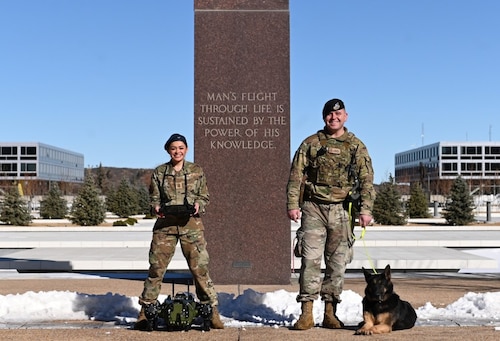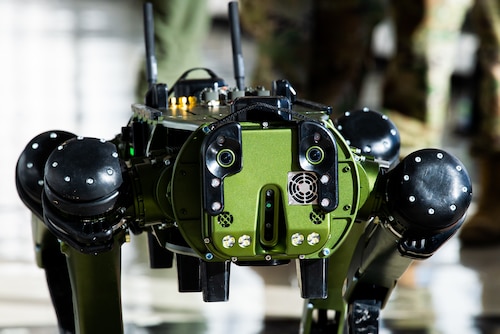A team of professors and cadets with the U.S. Air Force Academy's Warfighter Effectiveness Research Center, a directorate of the Department of Behavioral Sciences and Leadership, are striving to determine the practicality of incorporating a robot into operational Air Force missions.

The cadet-driven research focuses on gathering data and developing solutions to integrate a Ghost Robotics Vision 60 robot into base defense.
"Our primary objective in all research that is part of the WERC is to enrich cadet education through research focused on socio-technical systems in future conflict," said Lt. Col. James Walliser, WERC director. "The cadets on this project have learned an immense amount about the integration of robots in the military. We endeavor for all of our research to benefit the warfighter."
Employing modeling software
Senior and first-year cadets collaborate to define customer requirements for the robot by using the modeling software CATIA, or Computer Aided Three-Dimensional Interactive Application. The department provides the software licenses enabling cadets to employ model-based systems engineering concepts, according to Cadet 1st Class Leslie Cunamay, a systems engineering major and robotics team lead.
"During research we can lose sight of the primary mission requirements and sometimes bite off more than we can chew," Cunamay said. "But the software helps keep us on track, so we accomplish what's feasible given our objectives."
Cunamay and her team use CATIA to virtually reference logical and physical diagrams that detail the robot's functionality.
"If you're an operator, we can tell you that you'll be in charge of x, y and z and this is how it's going to affect you," Cunamay said. "Depending on your mission, we can determine how employing the robot can impact other positions across the operation, as well. CATIA helps us to better understand the robot's capabilities and limitations."
Testing performance
Cadet 1st Class Micah Treptau, a coding specialist, and Cadet 1st Class Justin Harmon, a robotics technician, are measuring how much power the robot's battery uses based on weight, distance traveled and time in operation. This information will prove valuable to future customers, according to Treptau.
"Our goal is to create a digital twin of the robot dog," Treptau said. "That way people can use the data to evaluate and simulate the best, most effective way to employ it."

The research also focuses on measuring human behavior and people's attitude toward being in close proximity to a robot.
"If we can get people to feel more comfortable with this [robot] then we can have it enter the workforce far more effectively," Treptau said.
Treptau surmised exposure to the robot as a primary solution to an individual's acclimation, an objective echoed by Walliser.
Warfighter and technology collaboration
"We're very focused on robot-human teaming and trust in automation and figuring out how people can control, operate and work with these new robotic and A.I. technologies," Walliser said. "It's a pillar of our research in the WERC."
The WERC became interested in the Vision 60 robot within the last few years due to other Air Force base's purchasing them for their own operations, according to Walliser.
"The exciting part is where this project could go over the course of the next few years," Treptau said. "What we're doing is just scratching the surface of modeling what the robot is capable of and then people can actually test out those capabilities in the future using the data that we collected."
The current team of cadets will wrap-up their projects and pass along lessons learned to the next class of cadet-researchers.






